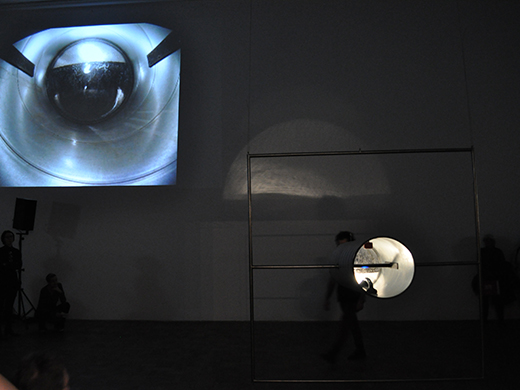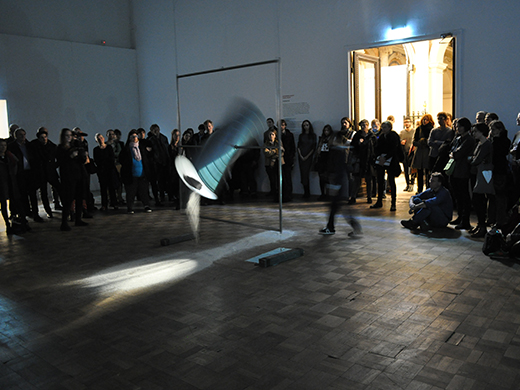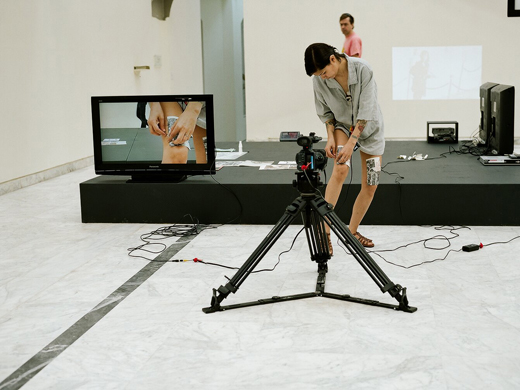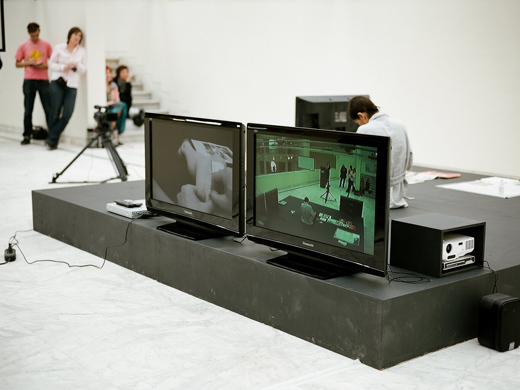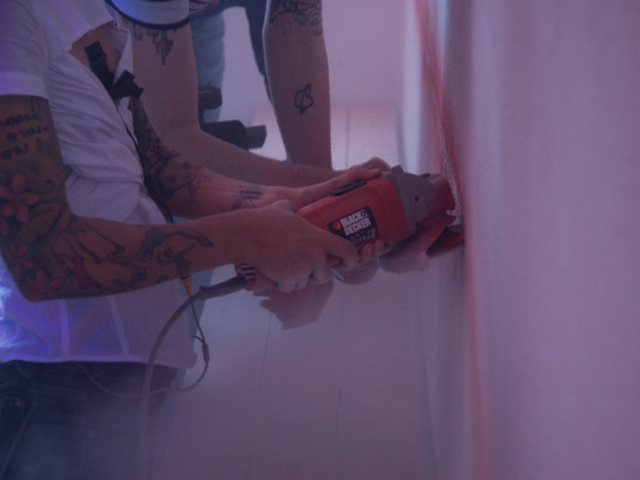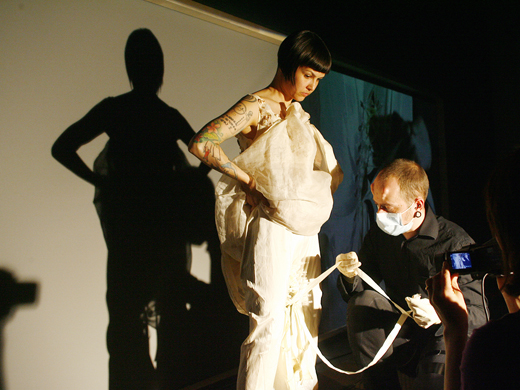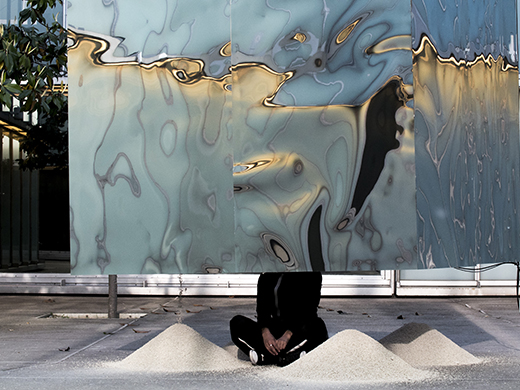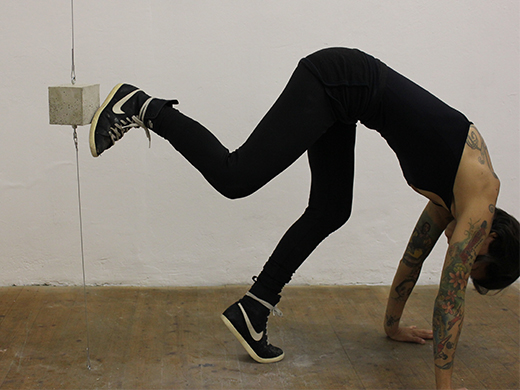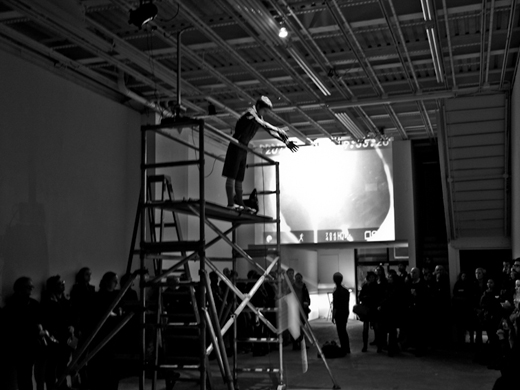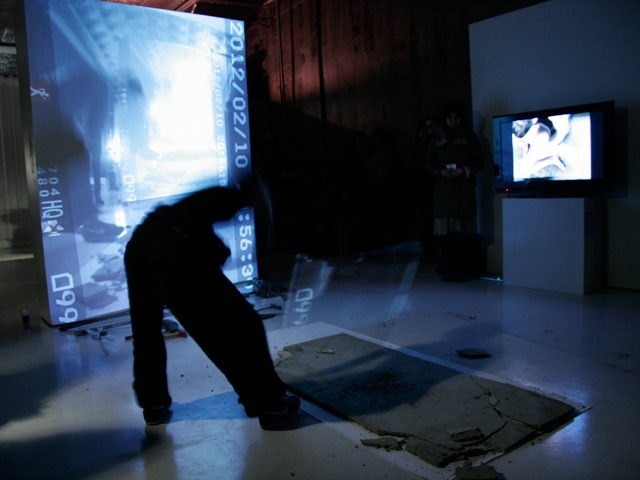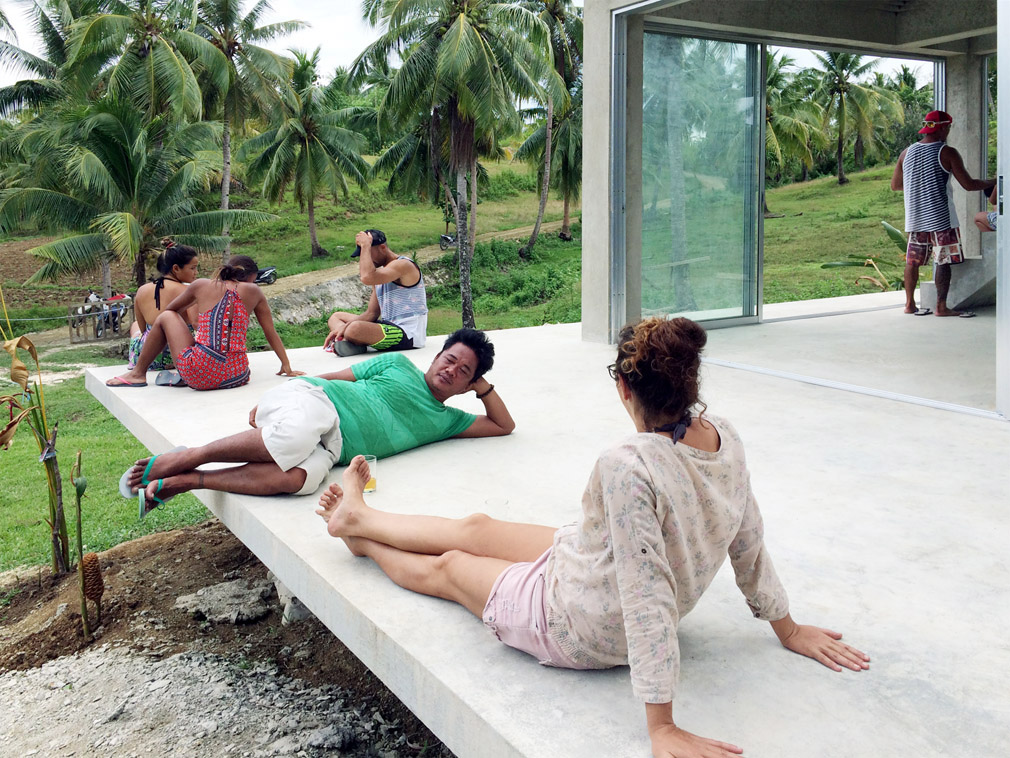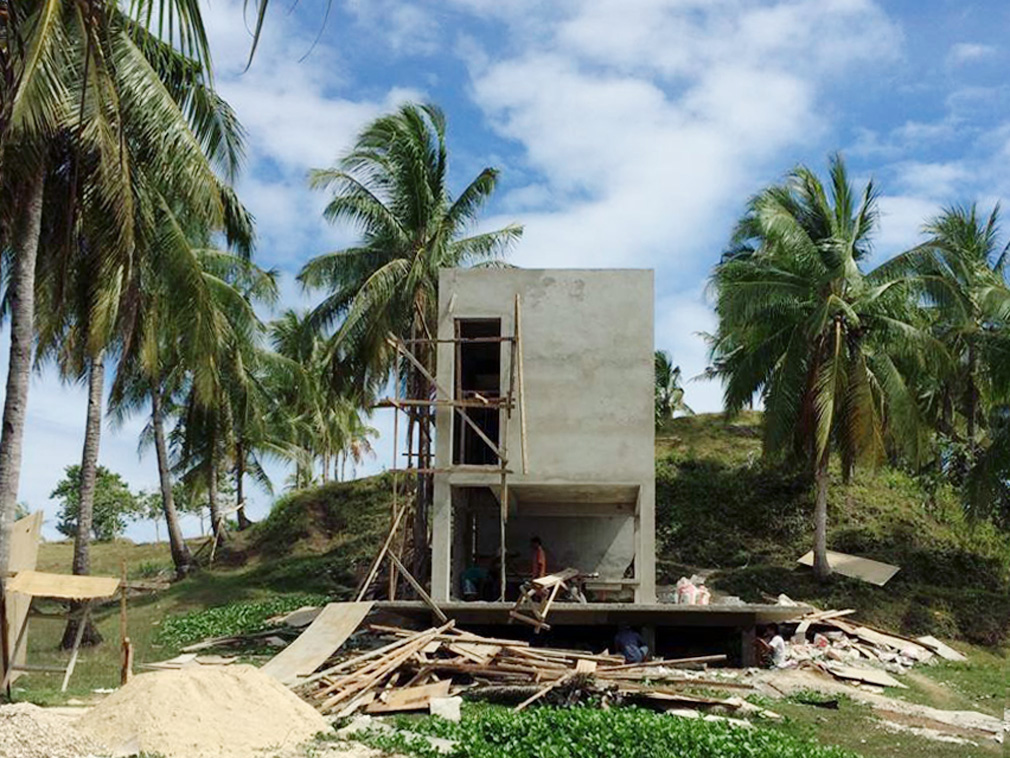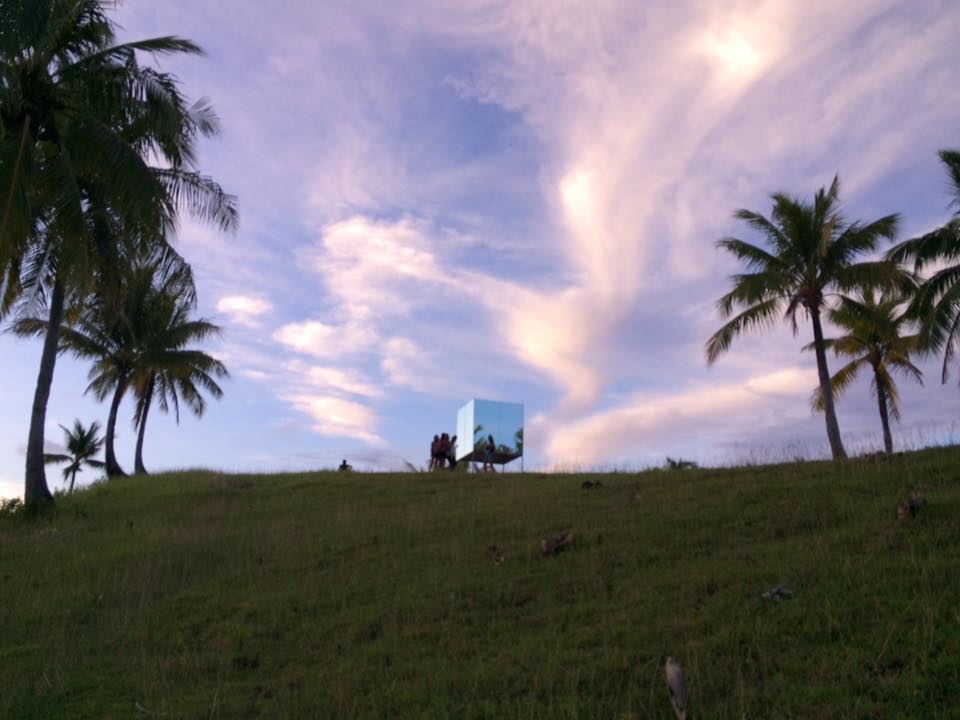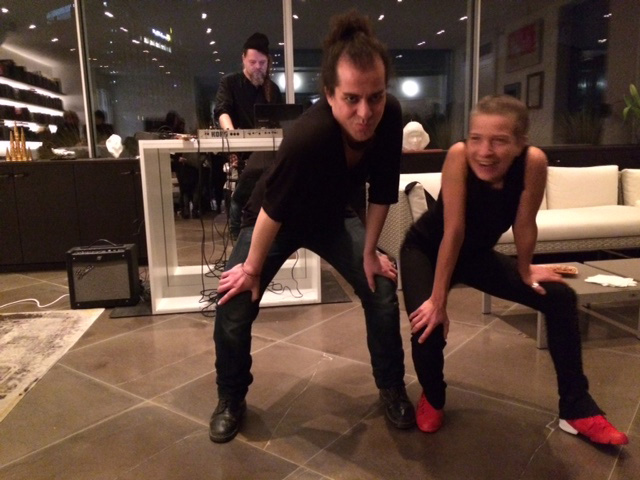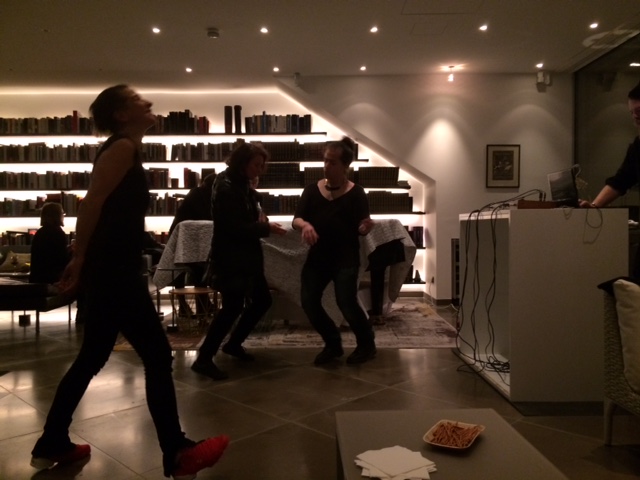interview
with Roberta Lima
info
In the context of Roberta Limas exhibition "rapture" - we had a short discussion.
Roberta Lima
I invited you, Erika, for this chat, not only because we are partners in the Tracing New Ways project in the Philippines, but also because we are friends for over fifteen years. I invited you also not only as my architect and artist colleague, but also as a connoisseur of my art and my working process to debate the work that we chose for the Niche, which is called Rupture. I thought that “rupture” was the word, but also an image that best portrays a process, which has been part of my life perhaps since birth. This process continued when I migrated from Brazil and stumbled into the art scene here in Austria and I encountered an environment so rich in feminist and queer theories. It encouraged me to break with the norms that I carried with me: first by working with performances and the self-representation, and later with minimalist, geometric forms in architecture. I can point as an example to one of my latest works, Kaleidoscope, in which you participated in the performance at the Künstlerhaus last year. In this work, I framed a cylinder in a square, making it static. This frame was for me a representation of oppression, restriction: it cannot move, but when released, the cylinder starts to spin, revolving and revolting.
Erika Artaker and breaking out of the frame…
RL Exactly.
EA Like a Niche: Where you put something in and thereby define it as art. With the spinning cylinder you created an artwork that just explodes, and finds its own space, together with the space the other people in the audience are creating. The performance was the artwork, afterwards it was gone.
RL In your opinion, what is the difference between the space of the museum and the space of the Niche in relation to the size of the artwork we chose? You have also worked with placing objects and artworks in big spaces or architectonic spaces.
EA It breaks down all of your work into one piece: it is about process and within the process finding what you want to do. In a scientific process you start with a theory and you just try it out. It is also what you do when you live your life, you just collect and everything that comes out – is something new out of all the things you have thought and done. Presenting just a part of this process is this art piece.
RL What does it make an art piece? Is it the process and the history that comes with it, as you said, or is it the fact that we place it in the Niche?
EA It comes with all the history, you make it as an artwork and just say it is an artwork like Duchamp, but you integrate parts of the process within the artwork. What is art? Is it the broken piece or the piece in the gallery or the piece that you show in the art fair? Or the piece you sell? Or is it a present that you give to a friend? Or is it whatever you as an artist define what you want the others to see as art? Then just expose it to the audience and say: “This is something really cool, take a look at that”.
Erika Artaker and breaking out of the frame…
RL Exactly.
EA Like a Niche: Where you put something in and thereby define it as art. With the spinning cylinder you created an artwork that just explodes, and finds its own space, together with the space the other people in the audience are creating. The performance was the artwork, afterwards it was gone.
RL In your opinion, what is the difference between the space of the museum and the space of the Niche in relation to the size of the artwork we chose? You have also worked with placing objects and artworks in big spaces or architectonic spaces.
EA It breaks down all of your work into one piece: it is about process and within the process finding what you want to do. In a scientific process you start with a theory and you just try it out. It is also what you do when you live your life, you just collect and everything that comes out – is something new out of all the things you have thought and done. Presenting just a part of this process is this art piece.
RL What does it make an art piece? Is it the process and the history that comes with it, as you said, or is it the fact that we place it in the Niche?
EA It comes with all the history, you make it as an artwork and just say it is an artwork like Duchamp, but you integrate parts of the process within the artwork. What is art? Is it the broken piece or the piece in the gallery or the piece that you show in the art fair? Or the piece you sell? Or is it a present that you give to a friend? Or is it whatever you as an artist define what you want the others to see as art? Then just expose it to the audience and say: “This is something really cool, take a look at that”.
RL I guess that I have been playing a lot with these expectations of the audience. In 2008, after the Cairo biennale, I took the decision to stop using needles and started to work with other objects. The body remains central to the work until this day, but now I refer more directly to architecture. For instance, when I cut the wall in Ve.sch (Linear, 2010), I created a strong image similar to the ones I did in my earlier works, when using my body: The red cut in the wall. Because I had a Flex machine in my hand, people first thought I would hurt my body with the power tools, as I did before with the needles. People said: “Call an ambulance, Roberta has a Flex machine in her hand”. The expectation that I was the one that would get hurt (and not the wall) or that my body will get hurt (even if I don't “place” it in the Niche) will always be present. As the cut in the wall, the needles have now become a sculpture. Likewise, the broken cube that has a cut, a rupture, reinforces those expectations: the audience always finds violence in my work or some kind of aggression.
EA When something breaks, that is part of a process: you have to try it out. Like what happened with your piece for ButterflyStep IN/OUT White Cube (2014). You broke it and in the process a new artwork was revealed. I am sure you don't care a lot in the end what the audience makes from it, because you do what is interesting to you, but it is always an interaction with the audience, the people on the street are also your audience. Everybody is your audience in a way. It is a good “foundation” that you did the needles and worked in the space of your body. Now every object is connected to that kind of rupture that you did to a body. Which seems more intense than doing it to an object. When the audience now sees you with an object – then all of that is part of the story. You can express much more than you can with the object itself. And you now can start from here in interaction with the audience. That is why you changed gears. Before, it was just the space of the body, then objects and spaces. This is also part of your architectural education: you always think about space and how things work in space.
RL From the first works, such as The Rings (2005) or Inversion (2006-07), it was about positioning the cameras in the space: thinking the body within the space. However, the questions were about releasing myself from those norms that I brought from Brazil, breaking through. I also like to say that I had my coming out through my performances. It was not only a feminist statement, but I was also my coming out as queer. I had to conquer my space, as a migrant, as queer. In a way I was already working with decoloniality without even knowing. My reality is: I come from a colonized country and moved to Europe to make art in the white cube. I was trying to understand this by looking into my history so I could then set myself free from it, not by saying: “I come from the favelas, I come from the streets, I come from a very oppressive society”, but from my own personal experiences of repression and restriction. Those experiences were reenacted. In The Dress Trilogy (2007-2008) discipline was staged in order to understand what discipline is, so I could then free myself from discipline. What I am trying to say is that I come from a privileged Brazilian mid upper class family. I don't come from a background, which authorizes me to discuss the issues of being oppressed. In the beginning decolonial issues weren't as central as they are now for me. I think that is because somehow I needed to conquer this space of the arts and that is in fact a colonial strategy. I am somehow using colonial strategies to debate my role as a migrant artist and decolonialization of art production. What I am trying to say is: I am part of the white cube/ commercial art system; I use the tools and the technology to produce art within the capitalist white European background. I am a queer woman from a privileged class coming from the white cube and my representation of Funk carioca and this genre that is created in the favelas is a white cube representation. The way that I can think of colonialism, queer, feminism, is through rupture. I break the norms when I contextualize them. For the work Future Past Light Cones (2015-16) I used fertilizer to create a metaphor between capitalist production and fertility. As Martha Wilson said, I “milked the sculpture”. It was a way to start a feminist debate in architecture.
EA I think that your work is more general, the themes – feminism, colonialism, etc. – come with it. But the works deal with more general topics. It is about the oppressions you do not recognize, you find them, mark them, for yourself and the others. Finally you have objects out of these experiences. And you are having those because you are interested in doing it. You just have to try it out. Don’t talk it, walk it.
RL So it is about process…
EA It is also about making things kind of real. It is also the process when you are doing it, you spend time doing it, and you are really there and doing this concrete block and it takes time and you have to do it right and you have to put the things in at the right time and you think a lot during this time and at the end you have it, the object, and maybe you do it again or use it for something else. But you decide, this is the art project, you are doing it.
RL It is very clear for me, those processes. From the body to the space… the fact that architecture was always there even when I tried to deny it.
EA You learn ways of thinking, architects have ways of thinking, programmers have ways of thinking… And when you are an architect, you think about space, You are more sensitive about how space works. When you enter a space, you immediately feel if it is a good space or not, and you know how all the stuff is arranged within the space. You create spaces with objects. The cube in Future Past Light Cones Siargao (2016) is not the art object, the architecture, it is the Facebook posts from the people that went there, having fun, kissing…It is the space, that is created.
RL During the performance in Siargao, you could see these various things, like copying and pasting in Photoshop: the piece of a tree that was reflected superimposed on the background or the audience that was watching the performance. It was when I realized that I was able to do what I have been talking about in all these years! And you know it very well, because you have been there with me also for the production of the catalogues and all. I've been talking so much about redirectioning the camera, taking the camera away from me…
EA It is not even on the object. I mean, you know this kind of object, a really nice scandinavian tree-lodge looks like this… It is not about the mirrored cube, everybody can do this object, but – create the space.
RL Changing the landscape… That is what I learned with performance. I don’t think I could have achieved to make those statements “only” as an architect. The background and my process with performances made me realize what is the constitution of space. As architects we are trained to create beautiful objects and place them somewhere, keeping them and their users as safe and confortable as possible. And as you say, anyone can interact with them. But as a performer I had the liberty of experimenting with failure, with the unexpected. Rupture stands for that, it stands for my feminist statement in architecture and also in the art as a process that includes failure and break: of the norms, the space, and pre-established rules. You cannot create new landscapes if you do not break with pre-arranged set of rules. The work in Siargao was initially planned for an art space, but because our partners in the Philippines pulled back, we no longer had this possibility. So I said “let's do it in open space”. Then you see what is the point of doing art. It is not about where you do it, it's not about whether it is in a museum, or in the Niche, or in the open space. It is about what people do with the object and the new meanings that will be found.
EA When something breaks, that is part of a process: you have to try it out. Like what happened with your piece for ButterflyStep IN/OUT White Cube (2014). You broke it and in the process a new artwork was revealed. I am sure you don't care a lot in the end what the audience makes from it, because you do what is interesting to you, but it is always an interaction with the audience, the people on the street are also your audience. Everybody is your audience in a way. It is a good “foundation” that you did the needles and worked in the space of your body. Now every object is connected to that kind of rupture that you did to a body. Which seems more intense than doing it to an object. When the audience now sees you with an object – then all of that is part of the story. You can express much more than you can with the object itself. And you now can start from here in interaction with the audience. That is why you changed gears. Before, it was just the space of the body, then objects and spaces. This is also part of your architectural education: you always think about space and how things work in space.
RL From the first works, such as The Rings (2005) or Inversion (2006-07), it was about positioning the cameras in the space: thinking the body within the space. However, the questions were about releasing myself from those norms that I brought from Brazil, breaking through. I also like to say that I had my coming out through my performances. It was not only a feminist statement, but I was also my coming out as queer. I had to conquer my space, as a migrant, as queer. In a way I was already working with decoloniality without even knowing. My reality is: I come from a colonized country and moved to Europe to make art in the white cube. I was trying to understand this by looking into my history so I could then set myself free from it, not by saying: “I come from the favelas, I come from the streets, I come from a very oppressive society”, but from my own personal experiences of repression and restriction. Those experiences were reenacted. In The Dress Trilogy (2007-2008) discipline was staged in order to understand what discipline is, so I could then free myself from discipline. What I am trying to say is that I come from a privileged Brazilian mid upper class family. I don't come from a background, which authorizes me to discuss the issues of being oppressed. In the beginning decolonial issues weren't as central as they are now for me. I think that is because somehow I needed to conquer this space of the arts and that is in fact a colonial strategy. I am somehow using colonial strategies to debate my role as a migrant artist and decolonialization of art production. What I am trying to say is: I am part of the white cube/ commercial art system; I use the tools and the technology to produce art within the capitalist white European background. I am a queer woman from a privileged class coming from the white cube and my representation of Funk carioca and this genre that is created in the favelas is a white cube representation. The way that I can think of colonialism, queer, feminism, is through rupture. I break the norms when I contextualize them. For the work Future Past Light Cones (2015-16) I used fertilizer to create a metaphor between capitalist production and fertility. As Martha Wilson said, I “milked the sculpture”. It was a way to start a feminist debate in architecture.
EA I think that your work is more general, the themes – feminism, colonialism, etc. – come with it. But the works deal with more general topics. It is about the oppressions you do not recognize, you find them, mark them, for yourself and the others. Finally you have objects out of these experiences. And you are having those because you are interested in doing it. You just have to try it out. Don’t talk it, walk it.
RL So it is about process…
EA It is also about making things kind of real. It is also the process when you are doing it, you spend time doing it, and you are really there and doing this concrete block and it takes time and you have to do it right and you have to put the things in at the right time and you think a lot during this time and at the end you have it, the object, and maybe you do it again or use it for something else. But you decide, this is the art project, you are doing it.
RL It is very clear for me, those processes. From the body to the space… the fact that architecture was always there even when I tried to deny it.
EA You learn ways of thinking, architects have ways of thinking, programmers have ways of thinking… And when you are an architect, you think about space, You are more sensitive about how space works. When you enter a space, you immediately feel if it is a good space or not, and you know how all the stuff is arranged within the space. You create spaces with objects. The cube in Future Past Light Cones Siargao (2016) is not the art object, the architecture, it is the Facebook posts from the people that went there, having fun, kissing…It is the space, that is created.
RL During the performance in Siargao, you could see these various things, like copying and pasting in Photoshop: the piece of a tree that was reflected superimposed on the background or the audience that was watching the performance. It was when I realized that I was able to do what I have been talking about in all these years! And you know it very well, because you have been there with me also for the production of the catalogues and all. I've been talking so much about redirectioning the camera, taking the camera away from me…
EA It is not even on the object. I mean, you know this kind of object, a really nice scandinavian tree-lodge looks like this… It is not about the mirrored cube, everybody can do this object, but – create the space.
RL Changing the landscape… That is what I learned with performance. I don’t think I could have achieved to make those statements “only” as an architect. The background and my process with performances made me realize what is the constitution of space. As architects we are trained to create beautiful objects and place them somewhere, keeping them and their users as safe and confortable as possible. And as you say, anyone can interact with them. But as a performer I had the liberty of experimenting with failure, with the unexpected. Rupture stands for that, it stands for my feminist statement in architecture and also in the art as a process that includes failure and break: of the norms, the space, and pre-established rules. You cannot create new landscapes if you do not break with pre-arranged set of rules. The work in Siargao was initially planned for an art space, but because our partners in the Philippines pulled back, we no longer had this possibility. So I said “let's do it in open space”. Then you see what is the point of doing art. It is not about where you do it, it's not about whether it is in a museum, or in the Niche, or in the open space. It is about what people do with the object and the new meanings that will be found.
EA The things you learn while you do them is an experience of space, skating, snowboarding, surfing, growing up,.. The audience is also a kind of space, it perhaps invades you, when the room is too full. Seeing, while you are making it, things turn: When are secure enough of yourself, you can just play with it. When something is not possible, like in Manila, you use this and make it part of your project. These things are a huge part of the process because whenever you are doing something, your first plan has not to be the best one, because you get better and better in time. Let it evolve within this process, like biology. It’s hard to say what’s perfect.
RL Restriction is my motivation. If I hear a "No" (and I heard lots of "No" since I was born) I use as my vitamin, my food, to do it even more. I have to put myself out there and just do it, otherwise how can I say it is too hard? And then I take advantage of being feminist in Vienna: First I execute, and later I can complain (laughs).
EA Rupture, the cube, this new artwork just exists because of the concrete cube you first made for the performance of ButterflyStep IN/OUT White Cube (2014). The handle was to short and then it broke.
RL The story of this sculpture goes back to the time in Chicago during a residency in 2011 when I started to work very intensively with concrete. I was interested in the balance between beauty -as we learn it in architecture - and disruption - that I know so well from the performances. Suspended (2011) is a series of photography that shows my exercise, my experience of throwing a cube in the air. In 2012 I performed Displacement at the White Box, New York. For this work I built a concrete cube with a camera inside, as a metaphor for displacing the camera from the body into the space. During the performance I dropped this cube from three meters height on a platform of concrete. Later I also did ReBirth (2012) when my body was thrown against concrete. This debate of the body, space, concrete, and rupture is already five years old, but the way it still finds new meanings interests me so much. In ButterflyStep IN/OUT White Cube, I display my incapacity of performing a Brazilian dance, a variation of twerk that is called “quadradinho de oito”, which means "eight points square". When Brazilians twerk they move their bodies as if they would form a cube. This work is also a result of an intensive exchange with my dear friend and Brazilian artist Pedra Costa, who refers to twerk as a decolonial strategy. My realization was that I am simply not a woman who could twerk. The representation of a colonialized Brazilian woman: who in reality cannot move at all!
EA Like Austrians that cannot yodel…
RL It is quite the same. The ButterflyStep IN/OUT White Cube is actually my attempt to again, use a colonial strategy, in this case of cultural appropriation, to question artistic production. I kick the white cube, here represented by the little concrete sculpture. The first sculpture that I did broke, so I had to do a second one, which was then used for making the video. The same mold that I used to make Rupture served to build the second cube of the video ButterflyStep IN/OUT White Cube, was also used to make one called Capture that was exhibited in New York in 2014. It is very important that I used the same mode for all of them, because it tells the tragedy of these concrete cubes. The first broke, but remained in the Atelier because I could not get rid of it, but I found something very appealing about this object. The second was used in the performance video, and the third was send to NY, placed in a pedestal and exhibited inside a very polished glass cube. This also tells the story of how a work can be placed and how this affects the meaning of the work. It comes back to our discussion today: the broken cube now being placed in the Niche, offers more value for me than any other that I exhibited. It has history. It also carries both concept and aesthetic, which are very important for me.
EA It is also a good place to show it here because they will appreciate, they know the story and the whole process, you can just show it as it is, the same way you had it at home, as a really nice object. Broken, rough. You know it will fit, if you want it to.
RL And you can place it the way you want.
EA All works are just parts. This is one part, this is the other part, it also reflects what an art piece is, a performance, an object you buy, you define it, whatever
RL For me as an architect it is difficult to accept failure, but as a performer it is really something that keeps me going. Being given the possibility of using the Niche to showcase something that has so many meanings is really important for me. And together with our conversation, the collaboration with das_em, and the poster I also think it makes it complete. That is I chose this work together with Itai. It looks so simple and somehow banal, and that is why we did not want it to have any kind of self-explanatory presentation. But for me, it stands for a lot of things that I believe and that I worked so hard to enable to the audience. After all, it is not about caring or not caring what the audience expects or thinks of me, but it is about caring if the message comes across the way I wish it would. This is what makes me go on with doing things that are not the most pleasurable, like building the house in the Philippines. It was hard! But you know how hard these things can be, as you just recently had an experience like that.
EA I thought of that when you said, as an architect you want perfection. For me as an architect you have to learn to go with the flow somehow, because engineering is a social process. It is always about a lot of people that are involved, their way of thinking and motivation. It is clear from the beginning that it is a process and if it doesn't work out with the people you are working with, it doesn't work, you cannot do it alone, it has to be evolved. As an artist, how is it, are you doing it alone?
RL No, definitely not, without the collaboration of so many people I would have never achieved anything, not only in the arts. Without you for example, or so many others that helped me, people who think together with me. Even the cameras, I call them my co-workers. For me collaboration is essential. In the architecture as well: I don't see the construction workers as workers, I see them as collaborators. Even the weather has to collaborate otherwise you don't get it done. As a feminist, it is definitely not about understanding but it is about solidarity, the community. Architecture, art, and political positioning such as feminist or queer are in my opinion about community. I cannot achieve what I want in the arts without having the element of community sharing. That is what I experienced in the Philippines. The fact that people go there, make Instagram pictures and share them with everybody. It is the sense of sharing and exchange that keeps me going. I am more and more convinced that the works deserve to be out there, if not on the top of a hill then in the Niche, or in the collections, in the catalogues, in the folder, in the poster. I put my body and my face out there, I believe these objects belong out there too.
RL Restriction is my motivation. If I hear a "No" (and I heard lots of "No" since I was born) I use as my vitamin, my food, to do it even more. I have to put myself out there and just do it, otherwise how can I say it is too hard? And then I take advantage of being feminist in Vienna: First I execute, and later I can complain (laughs).
EA Rupture, the cube, this new artwork just exists because of the concrete cube you first made for the performance of ButterflyStep IN/OUT White Cube (2014). The handle was to short and then it broke.
RL The story of this sculpture goes back to the time in Chicago during a residency in 2011 when I started to work very intensively with concrete. I was interested in the balance between beauty -as we learn it in architecture - and disruption - that I know so well from the performances. Suspended (2011) is a series of photography that shows my exercise, my experience of throwing a cube in the air. In 2012 I performed Displacement at the White Box, New York. For this work I built a concrete cube with a camera inside, as a metaphor for displacing the camera from the body into the space. During the performance I dropped this cube from three meters height on a platform of concrete. Later I also did ReBirth (2012) when my body was thrown against concrete. This debate of the body, space, concrete, and rupture is already five years old, but the way it still finds new meanings interests me so much. In ButterflyStep IN/OUT White Cube, I display my incapacity of performing a Brazilian dance, a variation of twerk that is called “quadradinho de oito”, which means "eight points square". When Brazilians twerk they move their bodies as if they would form a cube. This work is also a result of an intensive exchange with my dear friend and Brazilian artist Pedra Costa, who refers to twerk as a decolonial strategy. My realization was that I am simply not a woman who could twerk. The representation of a colonialized Brazilian woman: who in reality cannot move at all!
EA Like Austrians that cannot yodel…
RL It is quite the same. The ButterflyStep IN/OUT White Cube is actually my attempt to again, use a colonial strategy, in this case of cultural appropriation, to question artistic production. I kick the white cube, here represented by the little concrete sculpture. The first sculpture that I did broke, so I had to do a second one, which was then used for making the video. The same mold that I used to make Rupture served to build the second cube of the video ButterflyStep IN/OUT White Cube, was also used to make one called Capture that was exhibited in New York in 2014. It is very important that I used the same mode for all of them, because it tells the tragedy of these concrete cubes. The first broke, but remained in the Atelier because I could not get rid of it, but I found something very appealing about this object. The second was used in the performance video, and the third was send to NY, placed in a pedestal and exhibited inside a very polished glass cube. This also tells the story of how a work can be placed and how this affects the meaning of the work. It comes back to our discussion today: the broken cube now being placed in the Niche, offers more value for me than any other that I exhibited. It has history. It also carries both concept and aesthetic, which are very important for me.
EA It is also a good place to show it here because they will appreciate, they know the story and the whole process, you can just show it as it is, the same way you had it at home, as a really nice object. Broken, rough. You know it will fit, if you want it to.
RL And you can place it the way you want.
EA All works are just parts. This is one part, this is the other part, it also reflects what an art piece is, a performance, an object you buy, you define it, whatever
RL For me as an architect it is difficult to accept failure, but as a performer it is really something that keeps me going. Being given the possibility of using the Niche to showcase something that has so many meanings is really important for me. And together with our conversation, the collaboration with das_em, and the poster I also think it makes it complete. That is I chose this work together with Itai. It looks so simple and somehow banal, and that is why we did not want it to have any kind of self-explanatory presentation. But for me, it stands for a lot of things that I believe and that I worked so hard to enable to the audience. After all, it is not about caring or not caring what the audience expects or thinks of me, but it is about caring if the message comes across the way I wish it would. This is what makes me go on with doing things that are not the most pleasurable, like building the house in the Philippines. It was hard! But you know how hard these things can be, as you just recently had an experience like that.
EA I thought of that when you said, as an architect you want perfection. For me as an architect you have to learn to go with the flow somehow, because engineering is a social process. It is always about a lot of people that are involved, their way of thinking and motivation. It is clear from the beginning that it is a process and if it doesn't work out with the people you are working with, it doesn't work, you cannot do it alone, it has to be evolved. As an artist, how is it, are you doing it alone?
RL No, definitely not, without the collaboration of so many people I would have never achieved anything, not only in the arts. Without you for example, or so many others that helped me, people who think together with me. Even the cameras, I call them my co-workers. For me collaboration is essential. In the architecture as well: I don't see the construction workers as workers, I see them as collaborators. Even the weather has to collaborate otherwise you don't get it done. As a feminist, it is definitely not about understanding but it is about solidarity, the community. Architecture, art, and political positioning such as feminist or queer are in my opinion about community. I cannot achieve what I want in the arts without having the element of community sharing. That is what I experienced in the Philippines. The fact that people go there, make Instagram pictures and share them with everybody. It is the sense of sharing and exchange that keeps me going. I am more and more convinced that the works deserve to be out there, if not on the top of a hill then in the Niche, or in the collections, in the catalogues, in the folder, in the poster. I put my body and my face out there, I believe these objects belong out there too.
Roberta Lima was born in 1974 in Manaus, Brazil.
After graduating with a degree in architecture in 2002, she moved to Vienna. In 2007, after earning a Master’s degree in Fine Arts, she began her PhD studies at the Academy of Fine Arts Vienna. Roberta focuses on her own body as theme for her work and uses various media, such as photographs, video and installations. Additionally she investigates space and appropriates aspects of different places and contexts — from subculture to science, from popular media to historical reference and feminist theory — for producing art and starting discussions on the role of artist and viewer.
www.robertalima.com Erika Artaker
studied: Fine Arts / Photograpy (Academy of Fine Arts Vienna) 2008, Architecture (TU-Wien) 2000
lived in: Vienna, Berlin, New York, Hong Kong, London, Beijing
did: 10110.org
Visualisation and 3D modelling, interface design, web design
Architecture / house, apartment, furniture, concept, exhibition, permanent intervention
Graphics / corporate identity, books, art production, consulting
Surfing, skydiving, paragliding, cycling, hiking, computer gaming, mandarin
Art / group exhibitions, projects territoryoftruth.com
likes: geometry, space, science, biology, engineering, computer, sci-fi
After graduating with a degree in architecture in 2002, she moved to Vienna. In 2007, after earning a Master’s degree in Fine Arts, she began her PhD studies at the Academy of Fine Arts Vienna. Roberta focuses on her own body as theme for her work and uses various media, such as photographs, video and installations. Additionally she investigates space and appropriates aspects of different places and contexts — from subculture to science, from popular media to historical reference and feminist theory — for producing art and starting discussions on the role of artist and viewer.
www.robertalima.com Erika Artaker
studied: Fine Arts / Photograpy (Academy of Fine Arts Vienna) 2008, Architecture (TU-Wien) 2000
lived in: Vienna, Berlin, New York, Hong Kong, London, Beijing
did: 10110.org
Visualisation and 3D modelling, interface design, web design
Architecture / house, apartment, furniture, concept, exhibition, permanent intervention
Graphics / corporate identity, books, art production, consulting
Surfing, skydiving, paragliding, cycling, hiking, computer gaming, mandarin
Art / group exhibitions, projects territoryoftruth.com
likes: geometry, space, science, biology, engineering, computer, sci-fi
September 28th, 2025
